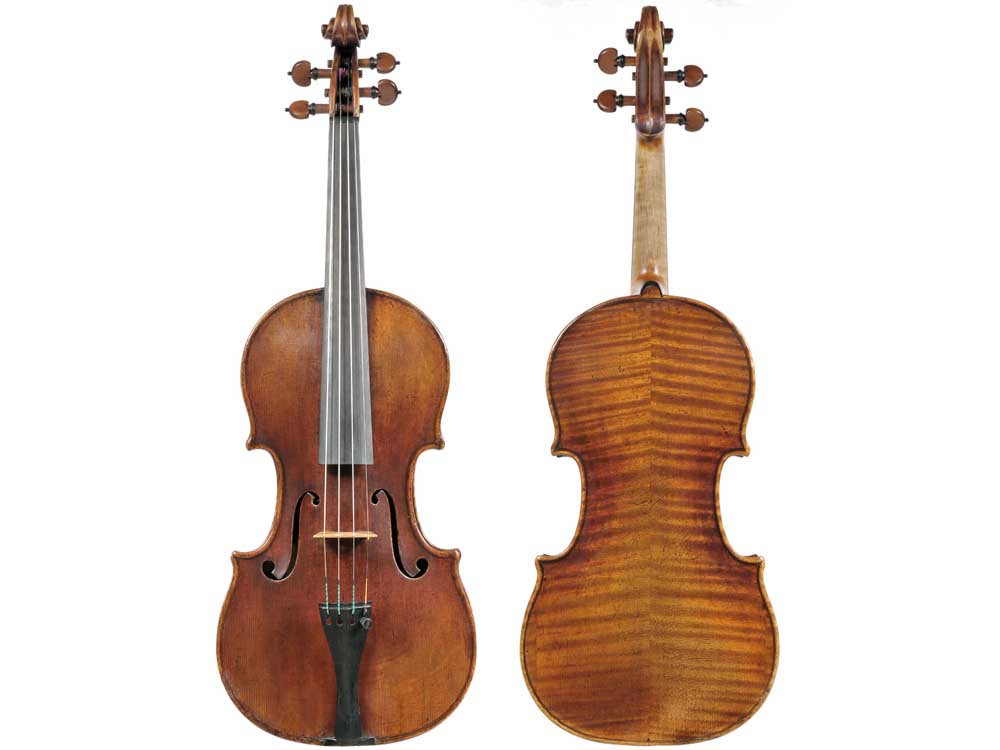300-year-old Stradivarius violin visits Bend
Published 12:00 am Saturday, November 14, 2015

- Michael Darnton / Submitted photoThe 300-year-old Lipinski Stradivarius, now played by Frank Almond, concertmaster for the Milwaukee Symphony Orchestra.
Even if you know little to nothing about violins, you’ve likely heard the term Stradivarius.
Named after the Stradivari family — particularly the brilliant luthier Antonio Stradivari — of 17th- and 18th-century Cremona, Italy, Stradivarius violins are prized to this day for their gorgeous tone and excellent craftsmanship.
Born in 1644, Stradivari is estimated to have made more than 1,000 stringed instruments in his 93 years of life, the majority of them violins. According to several sources, about 640 of Stradivari’s instruments survive, about 500 of them violins. The instruments tend to have accumulated colorful histories as they’ve passed from one owner to the next, outliving them all.
Every once in awhile, Stradivarius violins — valued at millions of dollars — disappear for a time or, more rarely, get stolen.
In the case of the Lipinski Stradivarius acclaimed violinist Frank Almond performs on, it has previously gone missing AND been stolen.
Karol Lipinski
The Lipinski Stradivarius is celebrating its 300th birthday this year. Almond, who will be in concert Friday in Bend, explained how it came to be named after one of its former owners.
“Karol Lipinski was a major figure in 19th-century Europe who’s been almost totally forgotten now,” Almond said by phone from Milwaukee, Wisconsin, where he’s concertmaster of the Milwaukee Symphony Orchestra.
Lipinski would host “these 19th-century ‘American Idol’-type events, these open playoffs with Nicolo Paganini and a lot of very famous musicians of the day,” said Almond, 51.
Lipinski rubbed elbows with such contemporaries as Clara and Robert Schumann — in fact, Schumann dedicated his great piano work “Carnaval” to Lipinski. “People play ‘Carnaval’ all the time, and nobody knows who Lipinski is,” Almond said.
Prior to Lipinski, the violin had another famous owner whose light has continued to shine more brightly. “The first-known owner of this violin is Giuseppe Tartini, an 18th-century composer and violinist whose “Devil’s Trill” sonata is still performed today.
“Why it’s not called the Tartini Strad, I don’t know,” Almond said.
Almond takes possession
“Just the way the thing dropped out of the sky into the city of Milwaukee was also kind of intriguing,” Almond said. In 2008, an anonymous patron of the arts in Milwaukee contacted him.
“I literally got an email one morning from someone who had this violin,” he said.
Up to that point, Almond had heard once or twice a year from people “absolutely certain” — and dead wrong — they had unearthed a valuable Stradivarius in their attic.
Something about that latest email gave him pause. Though he does not consider himself an expert on instruments of that caliber, Almond had played and cared for Stradivarius violins before.
“There was enough detail in this email that I felt like it was something that needed some attention, or at least a response,” he said. So he reached out to a trusted friend about the mysterious violin.
“He is an expert,” Almond said. “I think I forwarded the email to him, and he said, ‘This has some stuff in it that nobody really knows.’ It turned out that the instrument had disappeared for about 20 years. It had been played, but it was sort of under the radar, especially for a golden-period Strad.”
Before its stretch of time off the grid, the last owner had been Richard Anschuetz, whose violinist wife, Evi Liivak — a sensation in the post-World War II years — acquired the Lipinski in 1962, according to Almond’s website, A Violin’s Life.
After Liivak’s death in 1996, Anschuetz did not part with the violin.
“He (Anschuetz) had these long family ties to the city of Milwaukee,” Almond said. After Anschuetz’s death in 2008, “his heirs were trying to figure out what to do with the instrument.”
They’d done their homework and knew Almond had played Stradivarius violins before.
“Really, the initial contact was just informational. They were looking at various options. They knew what they had, but they weren’t sure what to do,” he said.
Over the next few months, Almond became close to the heirs.
“Eventually, they decided they’d like to keep it around here and have it played,” he said. So they offered Almond the chance to perform on it.
“That’s like somebody giving you a Ferrari to drive around all the time,” he said. “I’d honestly had such incredible good fortune with a lot of really great instruments that I knew what it was, and I knew to be humbled by an opportunity like that. And I was. And I still am.”
2014 theft
Almond would go on to play his own substantial role in the Lipinski’s colorful history. On a bitterly cold night in January 2014, Almond played a concert, part of his Frankly Music chamber music series, at a Milwaukee venue.
After a short reception in the lobby, he headed back to his car about 20 feet from the stage door.
“I remember being really happy I was able to park so close, because I think it really was about 9 below. It was bad. I didn’t really want the violin out in the cold, and I was freezing, too.”
He noticed an idling van backed in to a spot next to his car.
“I thought it was kind of odd, but maybe they were picking up someone from the reception,” he said. A man got out of the van and approached Almond as he put the violin in his car.
“They just got closer and closer. It was strange because I didn’t understand why — I actually thought the person was going to talk to me or ask a question or something,” Almond said.
The man opened his coat, and Almond saw “these little flashing lights,” he said. “I thought, ‘Why is that guy taking my picture?’”
The man, now known to be Salah Salahadyn, didn’t seek an answer or photograph. He was an ex-convict with a strong interest, if not the aptitude, in becoming an art thief. The lights Almond saw were coming from a Taser.
“He fired the Taser, and I went down and immediately knew what was going on — because they’re very effective weapons,” he said, chuckling. “I guess I wasn’t down for very long but long enough for him to get the instrument off from my back and drive off in this crazy-looking, beat-up van, this Scooby-Doo van.”
Almond said it’s unusual for Stradivarius violins to get stolen, especially in such an obvious manner.
“Most of the time when these instruments disappear or are lost, it’s accidental. Somebody leaves it on a train or in a cab — that happens an alarming number of times … it’s happened at least 10 times that I can recall,” Almond said.
Such facts were little consolation that cold winter night.
“I was completely confused and hysterical,” Almond said. After 911 was called, police arrived within five minutes but did not immediately comprehend the urgency of the situation.
“We were trying to impress upon the initial responders what was going on,” Almond said, a smile in his voice. “There was this sort of Coen Brothers conversation. They were great; they were completely trying to do their job … but they (had) no idea what I was talking about.”
Beside the fact that they’d never heard of a Stradivarius violin, Almond’s assailant had used a Taser. And Tasers are not a commonplace weapon, it turned out.
“We went around in circles for quite a while, with me sitting in the back of a squad car,” Almond said. He tried to make calls but eventually the officers took away his phone.
“The police don’t really like that when they’re trying to interview you,” Almond said. “I was trying to get to Chief Flynn.”
That would be Edward Flynn, Milwaukee’s chief of police, whom Almond had met on several occasions.
“It just happened that the police chief of the city of Milwaukee is a big symphony fan. I knew he would get it right away. He’d understand, but I can’t tell these beat cops, ‘Hey, call your chief, because he’ll get it right away.’”
Todd Levy, an old friend and clarinetist who’d performed in the concert and rushed to Almond’s aid in the aftermath of the attack, was able to reach an orchestra board contact, one of the chief’s friends.
“He woke the chief up, and maybe two hours into it, somebody handed me a cellphone, and it was Chief Flynn,” Almond said. “And then everything changed.”
Calling in the cavalry
“He basically said he’s all in. ‘You gotta find this thing now,’” Almond said. Several more officers arrived, along with forensic investigators.
Almond kept busy the next several days, with polygraph tests and interviews and setting up a reward. He also spoke to art crime investigators from the FBI.
“One of them actually lives in Wisconsin. He was, of course, salivating,” Almond said. It became clear early on that there was probably no international crime syndicate involved.
It’s a myth, he said, that there’s a black market for the instruments.
“They’re not stolen because you can’t do anything with them. Literally, they’re worthless as soon as you steal them,” he said. “There is sort of a black market for paintings; there’s no evidence to suggest that that exists for musical instruments. There’s no Dr. Evil petting a white cat directing someone to steal a Strad. It’s never happened, according to the FBI anyway.”
Nine days after it was stolen, detectives recovered the undamaged Lipinski Stradivarius, which had been stashed in a cold Milwaukee attic, wrapped in a blanket tucked inside a suitcase. Salahadyn pleaded guilty and was sentenced in November 2014 to seven years in prison, plus another five years of extended supervision.
Undamaged does not mean the Stradivarius is easy to play. But then it never was.
“Stradivaris are notoriously finicky, and they’re not all user-friendly. If you push them too hard, you wind up with counter-productive results,” Almond said, laughing. “It opens up whole new worlds for you to explore your strengths artistically, just like somebody giving you a canvas. Suddenly … from a hundred colors, you go to, like, 5 million colors. But at the same time, it can really amplify your weaknesses as well. That’s both a good thing and kind of a daunting thing.”
He’ll have the Stradivarius when he visits Bend on Friday for the first event in High Desert Chamber Music’s Spotlight Series. Almond and pianist Rachelle McCabe will give a recital titled “A Violin’s Life — The Lipinski Stradivarius.”
With a work by Tartini on the program, the concert has been programmed around the Lipinski’s rich history, and in 2013, Almond’s recording, which shared a title with the program, reached the top 10 on Billboard’s classical list during its first week of release.
Rest assured, the historic instrument is still in safe hands.
“I think it’s safe to say that that kind of event changed the way that a lot of people travel with and play these instruments and handle them publicly. I know a lot of my friends did,” he said. “I certainly have to do things differently.”
You could say Almond feels the weight of history when he wears it on his back.
“I’m passing through its life,” he said. “It’s going to be here longer than I am.”
— Reporter: 541-383-0349, djasper@bendbulletin.com






